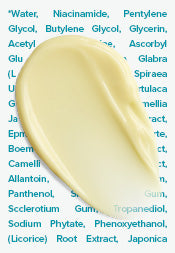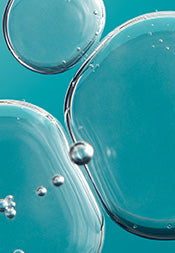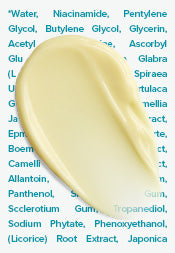What Can Niacinamide Benefits Do for the Skin?
Niacinamide has a plethora of benefits as a skincare ingredient, including its ability to:
- Minimise the appearance of enlarged pores and improve “orange peel” textured skin
- Restore skin’s defences against moisture loss and dehydration
- Visibly even out skin tone and discolourations from sun damage
Niacinamide is a standout among a handful of other amazing skincare ingredients such as retinol and vitamin C because of its versatility for almost any skincare concern and skin type. Just like products containing niacinamide, retinol skincare products help unclog pores, increase the production of skin cells and collagen, and reduce the appearance of wrinkles and fine lines. However, a combination of these ingredients can be a game changer as they work hand in hand in providing you with skincare products that are safe and gentle but truly work.
As many of you know about us, but for those who don’t, the conclusions we make about any ingredient are always based on what the published research has shown to be true—and the research about niacinamide unanimously demonstrates how special it is. Ongoing research keeps confirming it’s one of the most exciting skincare ingredients around.
What is Niacinamide?
Also known as vitamin B3 and nicotinamide, niacinamide is a water-soluble vitamin that works with the natural substances in your skin to help visibly minimise enlarged pores, tighten lax or stretched out pores, improve uneven skin tone, soften fine lines and wrinkles, diminish dullness, and strengthen a weakened surface.
Niacinamide also reduces the impact of environmental damage because of its ability to improve the skin barrier (your skin’s first line of defence), plus it also plays a role in helping skin to repair signs of past damage. Left unchecked, this type of daily assault makes skin appear older, dull, and less radiant.
What does Niacinamide do for your skin?
Niacinamide is most famous for its ability to reduce the appearance of enlarged pores. Research hasn’t come to a full understanding about how vitamin B3 works its pore-reducing magic, but it seems that niacinamide has a normalising ability on the pore lining, and that this influence plays a role in keeping oil and debris from getting backed up, which leads to clogs and rough, bumpy skin.
As the clog forms and worsens, the pores stretch to compensate, and what you’ll see are enlarged pores. Routine usage of niacinamide helps pores return to their natural size. Sun damage can cause pores to become stretched, too, leading to what some describe as "orange peel skin". Higher concentrations of niacinamide can help visibly tighten pores by shoring up skin’s supportive elements and often dramatically improving orange peel texture.
Other benefits of niacinamide are that it helps renew and restore the surface of the skin against moisture loss and dehydration. When ceramides become depleted over time, skin is left vulnerable to all sorts of problems, from persistent patches of dry, flaky skin to increasingly becoming extra-sensitive.
If you struggle with dry skin, topical application of niacinamide has been shown to boost the hydrating ability of moisturizers so the skin’s surface can better resist the moisture loss that leads to recurrent dry, tight, flaky skin. Niacinamide works brilliantly with common moisturizer ingredients like glycerin, non-fragrant plant oils, cholesterol, sodium PCA, and sodium hyaluronate.
How does niacinamide help discolourations and uneven skin tone? Both concerns stem from excess melanin (skin pigment) showing on the skin’s surface. Niacinamide in concentrations of 5% and greater works via several pathways to keep new discolourations from appearing. At the same time, it also helps reduce the appearance of existing discolourations, so your skin tone looks more even. Research has shown niacinamide and tranexamic acid work particularly well together, and as mentioned above, they can be used with other discolouration-reducing ingredients such as all forms of liquorice, retinol, bakuchiol, and vitamin C for the skin.
How to Use Niacinamide
Using niacinamide is as easy as finding great skincare products that contain it and applying it in order of:
- Cleanser
- Toner
- Exfoliant
- Layer the rest of your skincare serums, treatments, and moisturizers (including those with niacinamide) in order of thinnest to thickest texture
- During the day, finish with a broad-spectrum sunscreen rated SPF 30 or greater
Niacinamide is compatible with other powerful skin-restoring ingredients like peptides, hyaluronic acid, AHAs, BHA, and all types of antioxidants. This multi-ingredient approach to skincare is important because as great as niacinamide is for skin, it’s not the only ingredient skin needs to look and feel its best.
Think of it like your diet — as healthy as kale is, if kale was all you ate, you’d soon become malnourished because your body needs more than one healthy food to maintain itself. The same is true for skin, the body’s largest (and most exposed) organ.
How long does niacinamide take to work?
Generally speaking, you should start to see results after 2-4 weeks of twice-daily usage (depending on the severity of your skin concerns and how concentrated your niacinamide skincare product is). Ongoing use is required for continuous improvement.
Results will continue to improve over time but do not expect your skin to be completely “poreless”—that isn’t possible for any skincare product (not to mention, your skin needs its pores for many vital functions). What you can expect are pores that look smaller, skin tone that looks more even, visibly reduced fine lines and wrinkles, and an overall healthier glow.
Recommended Products
To optimise the results of using niacinamide in your daily routine use niacinamide skincare products that are meant to be left on the skin (such as serums or moisturizers) instead of rinse-off products (like cleansers) where contact time is limited.
A toner with niacinamide can be especially beneficial when applied after cleansing to rehydrate and replenish skin.
A concentrated 10% niacinamide booster can be used on its own (much like a serum) or mixed into your favourite non-SPF moisturizer, based on personal preference.
Those with stubborn concerns around advanced signs of sun damage, orange peel texture, lax pores, and oil-related bumps should consider trying an advanced strength 20% niacinamide serum.
You can use niacinamide-containing skincare products around your eyes, too. Some might find applying a moisturizer or eye cream with niacinamide helps soften the appearance of crow's feet and dark circles, not to mention enabling this delicate area to retain skin-smoothing moisture and resist loss of firmness as part of an anti-ageing routine.
For skin concerns beyond the face, a niacinamide body serum can also be advantageous. Niacinamide’s benefits on the body include tackling uneven tone, and discolourations (including dotted marks around the hair follicles), plus restoring and strengthening the skin’s surface. Our 5% Niacinamide Body Serum targets uneven tone and signs of ageing on the body, making it a terrific addition to any post-shower body care routine.
Shop niacinamide skincare and other ingredients at Paula’s Choice.
References for this information:
Journal of Drugs in Dermatology, May 2019, pages 454–459
Experimental Dermatology, February 2019, Supplement 1, pages 15-22; and October 2018, ePublication
Dermatologic Therapy, September 2017, ePublication
Journal of Investigative Dermatology, May 2017, page S116
International Journal of Pharmaceutics, March 2017, pages 158-162; and January 2013, Pages 192-201
International Journal of Dermatology, June 2016, pages e321–e326
Facial Plastic Surgery Clinics of North America, May 2016, pages 145-152
Clinical, Cosmetic, and Investigational Dermatology, July 2015, pages 405-412
Skin Pharmacology and Physiology, June 2014, pages 311-315
International Journal of Pharmacy, January 2013, pages 192-201
Dermatoendrocrinology, July 2012, pages 308-319
Dermatologic Surgery, Volume 31, Part 2, 2005, Discussion 865
International Journal of Cosmetic Science, October 2004, pages 231-238
Journal of Cosmetic Dermatology, March 2004, pages 88-93












